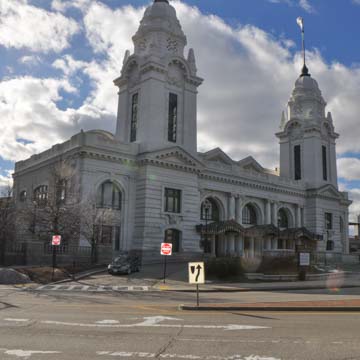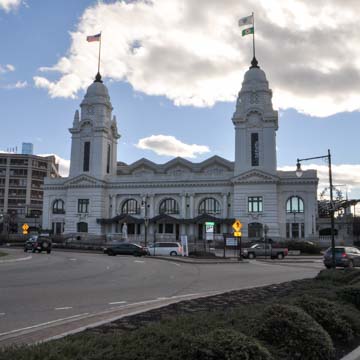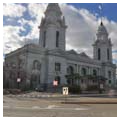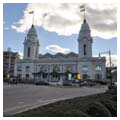When completed in 1911, Worcester’s Union Station functioned, as did many railroad stations of the era, as an architectural symbol for residents and visitors of the city’s vision as a prominent center of commerce and population. In the early twentieth century, the City of Worcester elevated its in-town railroad tracks to reduce street-level traffic congestion, which made its original Union Station (1875) obsolete. Therefore, the Boston and Albany Railroad (then leased by the New York Central) hired Huckel and Watson of Philadelphia in 1909 to build Worcester’s new Union Station. However, like its predecessor, it served nine separate railroads, including the Providence and Worcester Railroad; the Norwich and Worcester Railroad; the Worcester, Nashua and Rochester Railroad; and the Boston, Barre and Gardner Railroad. The confluence of so many lines both fed and reflected Worcester’s growing prominence as a site of industry. Indeed, it was one of the largest inland industrial cities in the country, the second most populous city in New England, and the 29th in the nation in 1900. Union Station was integral to Worcester’s success as a place of manufacturing, and so the city (and its railroad supporters) took advantage of the need for a new station to advertise its status and achievements.
Located a few blocks west of Worcester Common and the Main Street commercial downtown, Union Station predominated over Washington Square, an important crossroads linking the business district with Worcester’s Canal District and a main thoroughfare, Shrewsbury Street, that accessed State Route 9 to Boston (East) and Springfield (West). Facing northwest, the building’s main entrance provided easy access via a carriageway and, later, automobile traffic. By keeping its front entry turned away from the commercial strip, though, it represented the facade of the city. During its early-twentieth-century heyday, Union Station existed as a major source of civic pride and accommodated heavy passenger traffic on the order of 140 trains per day.
Designed in a classical style, the main body of the station is faced with glazed white terra-cotta. Marble Ionic half-columns frame the main entrance. The station sits on a granite foundation, itself an engineering challenge during construction due to the instability caused by the nearby Blackstone Canal bed (at the time used as a sewer). A pair of ornate, Baroque-style towers (each 175 feet tall), faced with white marble, flank the station’s three main entry arches. Due to structural weaknesses caused by the vibration of the trains, these were removed in 1926. Steel and concrete constitute the primary underlying building materials.
The interior is dominated by an 80 x 128–foot waiting room immediately behind a wide entry vestibule. The original, unisex waiting room featured an elliptical vault with intricate plaster and marble trim and elaborate stained glass windows. This primary space provided access to a separate, smaller, ladies’ waiting room and ladies’ café as well as public toilets and a ticket office. Behind the ticket office, via a smaller hall space, sat spaces catering to male clientele, such as a barbershop and smoking room. Behind the main waiting room, opposite the entry vestibule, sat another, semicircular vestibule that accessed the large baggage room and track boarding platform.
Despite a decline in use after World War II, a common fate of railroad stations nationwide, the structure survived the 1959 construction of I-290 through Worcester and the subsequent rise in automobile traffic. The landmark tower of its 1875 predecessor, adjacent and undisturbed to that point, fell to the highway project and was demolished in 1959. The loss of that earlier tower emerged as a compromise of sorts, allowing the declining Union Station to remain in exchange for the removal of a key obstacle to the highway’s route through the heart of Worcester. As was the case with so many other grandiose stations, Union Station fell into disrepair after the cessation of rail service in 1965 and its complete abandonment in 1974. There were several proposals for reusing the site in the late 1960s and early 1970s, including as a police station or community theater. In the 1980s, one entrepreneur considered adapting it into an indoor marketplace. None of these plans came to fruition, yet the structure survived for decades despite exposure to the elements.
The Worcester Redevelopment Authority acquired the building in 1995, completely renovated it at a cost of $32 million, and re-opened the station in July 2000. The restoration, designed by Finegold Alexander and Associates, included rebuilding the two towers lost in 1926, now using modern steel sheathed in molded fiberglass that would better withstand vibration and also reduce cost. The restored Grand Hall retains its original elliptical ceilings (with replacement stained glass), interior marble columns, and mahogany wood trim. The space also houses Luciano’s Cotton Club, a 1920s gangster-themed restaurant. Today, Union Station again serves passengers as a terminus on the MBTA’s Framingham/Worcester Commuter Rail Line as well as a stop on Amtrak’s Lake Shore Limited. As a result of I-290’s adjacent construction, some of the best views of Union Station, ironically, are obtained from a moving automobile.
References
Arsenault, Idamay Michaud. Worcester’s Union Station: The Monument and the Memories. Worcester, MA: Ambassador Books, 1999.
Morrill, Frank J., William O. Hultgren, and Eric J. Salomonsson. Worcester. Charleston, SC: Arcadia Publishing, 2005.
Pfeiffer, B. R.., “Union Station,” Worcester County, Massachusetts. National Register of Historic Places Inventory-Nomination Form, 1978. National Park Service, U.S. Department of the Interior, Washington, D.C.
Southwick, Albert B. 150 Years of Worcester: 1848-1998. Worcester, MA: Chandler House Press, 1998.
“Worcester, MA (WOR).” Amtrak. Accessed May 30, 2019. http://www.greatamericanstations.com/.




